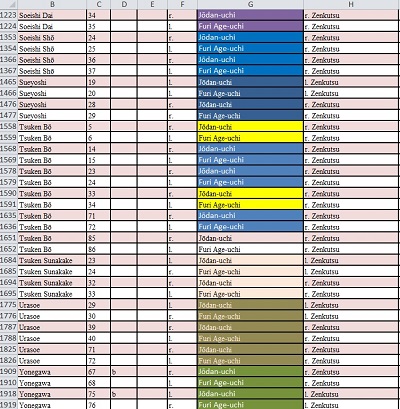As many other people, I also study some Kobudō from Japan as well as from Okinawa. Within this study, I conducted a technical survey of 1700+ individual techniques, which comprise of 100+ different methods of what is called bōjutsu or the “fencing techniques of the long staff.” This is from one single branch in the Taira tradition only.
By 2015 I had added the complete techniques of another branch from the same Taira tradition. A small visual basic program allowed further identifying, qualifying, and quantifying any combination of techniques found in all these kata.
So I was able to compare the designations, combative contents, deviation in the order of combinations etc.pp.
Of course I’ve been asked to share the tables, but I think it would be wrong and wouldn’t actually help anybody for various reasons. First of all, you would need to know all the kata, second you would need to know how the application works, and third you would need to have a result that you want to generate by it.
As regards the latter, the important thing is not the mere collection of techniques etc. in a table, but something completely different. People asked me if I’ve done something similar for the unarmed kata of karate, so I’ll explain it using this topic.
Well, I am sure you see the first huge difficulty already: If you want to identify, quantify, and qualify techniques, you first of all need a systematic terminology within a style. If a style doesn’t have this, you don’t have a reference model.
For example, the meaning of the word “uchi-uke” doesn’t properly describe the causal relationship between the term and the possible applications. However, you can still use the term “uchi-uke” to identify all of the moves that belong to this category, within a certain tolerance. Now you might have found out like 200 different applications for this “uchi-uke-like”-move.

Combination of “Jodan-uchi” + “Furi Age-uchi.” Given are (from left to right) Name of the kata the combi is found, number of the technique in source, …, left or right side, name of technique, stance.
With the table you’ve made you can now find any position in any kata that includes such an “uchi-uke-like”-move, and you can assign your 200 applications to any of it. Maybe sensei showed you a secret application for one of them only … but you just mirror it to all other occurences. In miliseconds.
You simply add or substract any number of “new” applications to any of these “uchi-uke-like”-move in any kata. You also add or substract kata to the list, or change the definition of your “uchi-uke-like”-move: The reference model already established will simply update.
Then you spent days going through videos and look for “uchi-uke-like”-move in Rambo movies, in real or in sports fight, in MMA, wrestling, judo, or medieval manuscripts. The moment you come across any application which might suit your “uchi-uke-like”-move, you just add and document it to your application list. And this, of course, is assigned to any “uchi-uke-like”-move at any position in any of your kata.
In this way, gradually, the number and combative content of the applications you found for your “uchi-uke-like”-move will cumulate asymptotically towards 100%. It is therefore similar to finding ever more decimal places for pi, if you like.
Above I considered individual techniques only. Now think of what happens when you extend this to combinations…
In other words, when it comes to the combative application of techniques in kata, either karate or kobudo, you will probably never again need a seminar in your life. However, It should be noted that the fabric of martial arts is made from the brother- and sisterhood of people, and not only from technique. But that’s what seminars are for.
Anyway, in the above way your inventory of your “application warehouse” will not simply reach the next level. It will cumulatively converge asymptotically towards 100%.
And the best thing is: you can always access it. Even if you forget it. One day we just use an interface and let robots do it. Using CABD (Computer Aided Bunkai Design™).
© 2016, Andreas Quast. All rights reserved.
